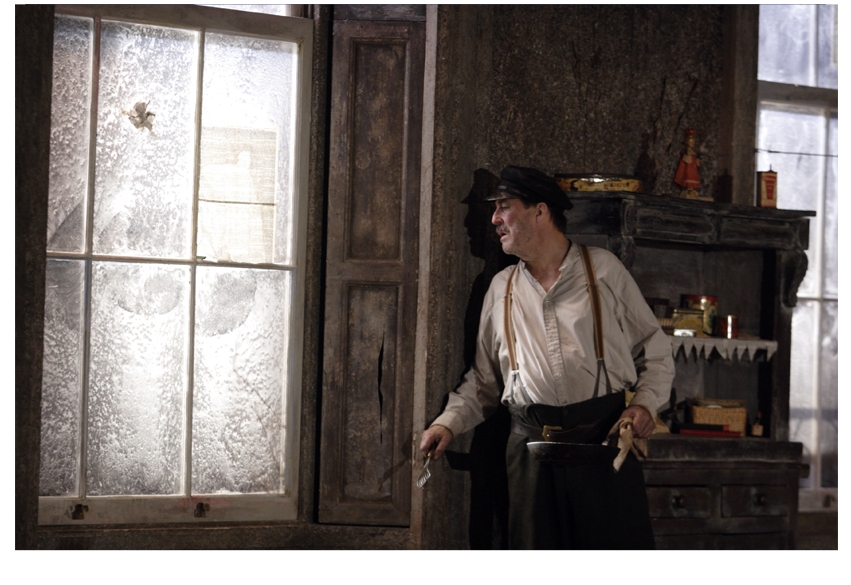Juno and the Paycock is a slice of documentary realism from the earliest years of the Irish Free State. The skint Boyle family are living like a gang of hobbits in the leprotic ruins of a grand Dublin townhouse. The paint blisters and peels. Diseased mortar crumbles into scabby flakes. The plaster-work centrepiece on the ceiling is like a charred meringue the size of a cartwheel. It’s grim. Money’s tight, food is scarce. Everyone’s depressed. There’s no work. The pride of the family, young John Boyle, would probably give his right arm to get a job if it hadn’t been blown off during the civil war.
Then a glimmer of hope. Cap’n Jack Boyle inherits a small fortune from a forgotten cousin. Hooray! The happy times are here. The Boyles go bananas. Well, sort of. They hire a carpenter to refurbish one of their exploding armchairs. And they buy a nice new table as well. And some cups. Their daughter Mary, the virgin bombshell obligatory in all Irish calamity yarns, catches the eye of the sleek young lawyer administering Cap’n Jack’s legacy. The family’s hopes are pinned on the saintly Mary’s marital prospects. Then disaster strikes. The will is invalid. The lawyer is a cad. The money vanishes. The furniture gets repossessed. The cups are returned. The food runs out. John’s arm still won’t grow back. Mary turns out to be less spotless than her immaculate namesake. So misery descends but it’s twice as bad this time because the hapless Boyles have quaffed from the sweet cup of prosperity.
The show, I have to say, is pretty near faultless. But the producers pay the author, Sean O’Casey, too high an honour in giving his static, morbid melodrama such skilful treatment. Bob Crowley’s pestilential design is a work of art in its own right. Take one look at that rancid ceiling and you start thinking about TB jabs.
Sinéad Cusack is tremulously convincing as the long-suffering matriarch, Juno, and Ciarán Hinds, playing Cap’n Jack, ably impersonates a seething mountain of wretchedness. Students of Irish history and aficionados of that Celtic speciality, conspicuous helplessness, will relish this huge dollop of woe but it’s a manifesto drama, a call to arms, a summons to slum-flattening and landlord-clobbering. And doubtless it created earthquakes when it first appeared. But 90 years on it looks like a corpse’s pageant or a gorgeous slice of nostalgia. ‘History,’ said Joyce, ‘is a nightmare from which I am trying to awake.’ Well, hello, everyone. It’s morning. No need to revisit last night’s horrors.
Cinderella at the Hackney Empire is a charming mishmash of tradition and modernity with an extra layer of beguiling irrelevances. As usual we start with poor old Cinders employed as a slave, but wearing fabulous hair and make-up, and forced to drudge for her execrably silly family elders. There are the usual corny gags and a ‘locally relevant’ plot to build a car park on the site of the Olympic Games. And we get a pair of Ugly Sisters (Kat B and Tony Whittle), who perform like ADHD sufferers during an attention famine. But in addition to these frivolities there’s a layer of unexpected style and artistry. A real sense of West End brio. The song-and-dance routines, which are hardly a staple of pantomime, are done with true verve and commitment.
Joanna Riding’s Wicked Stepmother is a complete musical performance. She’s unseasonally sexy, and has a fabulous singing voice, and the only drawback is that the score keeps curtailing the songs to prevent the toddlers from losing interest and running amok. Her husband, Baron Hardup (Peter Straker), ambles in and out of the action like Des O’Connor guest-presenting Newsnight. With his powder-blue suit, his Rat Pack twinkle, and his air of disengaged sophistication, Straker seems a million miles from panto. And that, quite often, is where panto makes me want to be.
The word seems to have spread that this is family entertainment which caters for adults, too. There were plenty of office parties at the performance I attended. If you can evade the inquisitions of the faintly officious staff, you’ll be able to wander around the multilayered and many splendoured theatre. It was built by Frank Matcham with a Californian disregard for spatial economy. It’s an ornamental treasure hunt of curious byways, unwarranted corridors, experimental vaults, concealed staircases and strange, counterintuitive passages. And it’s the only theatre I know where the stalls bar is physically one with the auditorium. So you can buy yourself a pint, and an introductory half for Junior, and enjoy an unimpeded view of the stage.







Comments